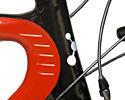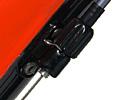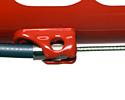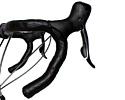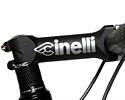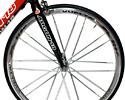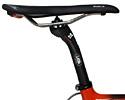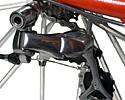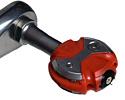
Recently on Cyclingnews.com |
On test: Argon 18 Gallium, March 22, 2006
Canadian carbon balance
Canada has had a burst of frame design creativity in the last several years. Hailing from Montreal, Argon18 hasn't had the high profile of its more famous compatriot companies, but bikes as good as its Gallium carbon fiber model will soon change that. Jon Kenny reports on a thoroughly well-thought-out road racing machine.

|
Argon 18 has been making frames since 1989, but the brand has only recently become well known outside its home country, Canada, and the triathlon circuit. Dane Torbj÷rn Sindballe smoked around the 2005 Hawaiian Ironman bike course on an Argon 18 bike in record time (4:21:36). He finished well out of the running overall, but his 41 kilometres per hour average over the 180-kilometre bike leg is staggering.
The FRF Couriers-Caravello Oceania Continental Team members are riding the Argon 18 Gallium this year. Their bikes are kitted out with Shimano Dura-Ace, Vuelta X-Lite wheels, Cinelli handlebars and stems and Selle Bassano saddles, which, by a remarkable coincidence is exactly how our test bike was equipped. Okay, not really remarkable - our bike came from the Australian importer which also sponsors FRF Couriers-Caravello. The team will compete in international races such as the Giro Del Capo in South Africa, The FBD Insurance Ras in Ireland and the Tour de Beauce in Canada.
Carbon mix
The Gallium, the top offering from Argon, has its stiffness and lightness enhanced through the use of "nanotechnology". This is slightly abstruse way of saying that very fine-grained ("nano"-sized) high-modulus fibres have been used as strengthening agents, as these fine grains are used to reinforce areas where most torsional loading is experienced.
Argon has also used a judicious amount of extra carbon around the head tube and bottom bracket, areas that are placed under high loads.
Specific Sizing Specs
The use of variable tube shapes takes into account the general weight increases of riders who ride large frames. Smaller frame sizes have the advantage of stiffness and lightness over large frames, but Argon has attempted to counter this imbalance.
The tube walls of the top and down tubes vary in density and thickness in each frame size. Argon 18 calls this "S3", for Specific Sizing Specs and it's a sign of a rare degree of attention to detail. It seriously fetters the economies of scale that normally come from mass-production, as each frame size shares little common tubing with the other sizes in the range, but Argon 18 is aiming to build a bike that provides superior handling and ride characteristics, regardless of frame size. Those economies of scale are less important when the frame is laid up in one piece, but Argon18 is still making extra work for its builders by specifying this level of detail.
The test bike (size large) came with a larger and more ovalised top tube than would be found on the 'XS'. Similarly, the down tube was more elongated where it abuts the head tube and rounder and more squat where it meets the bottom bracket.
Traditional practice encourages riders to select the smallest frame that they can get away with, as the use of less frame material makes them lighter and the smaller triangles makes the frame stiffer. One of the key selling points with the Gallium is that tubing used in the large frames in the range has a different profile to smaller frames. Large riders can select the best frame fit without compromise as the bigger frames have a different carbon mix to their more diminutive brothers.
Technical abbreviations
The Horizontal Dual System (HDS) has been used by Argon for over eight years and it means that the frame is diagonally divided into two areas, separated by an imaginary diagonal line from the top of the head tube to the rear dropouts. The lower half of the frame has most of the lateral support and rigidity through the profiling of the tubes and some reinforcing around the junctions. The top half is less beefed up as there is less stress placed on this area of the frame. The aim of this division is to provide a balance between stiffness and comfort by dissipating vibration on the top part of the frame, where rigidity is not as important as lower down.
Rounding out the set of abbreviations labelling the frame is RPT (Rear Power Transfer). Again, Argon has attempted to achieve a balance between rigidity and comfort, something that has largely been achieved. The profiling and bulk of the rear stays has given the Gallium a stiff rear end that is responsive under acceleration and when climbing out of the saddle. However, Argon's claim that, "The end result of all this is that 100 per cent of the rider's energy goes into propelling the bike forward," is improbable. The stays meet at CNC-machined carbon dropouts, the right of which has a replaceable derailleur hanger.
Ride
The Nanotech technology and the utilisation of S3 and HDS are not just examples of marketing techno-babble, as the frame displays the characteristics celebrated in the literature. The frame is remarkably stiff and comfortable. Whether this is a result of these Argon-specific building practices, or come about as a result of the inherent nature of carbon monocoque frame manufacture is probably a moot point. Ultimately, riders are happy with lightness, good fit, comfort and rigidity - all these boxes are ticked on the Gallium.
The large size tested is intended for riders who would normally ride a 57 - 59 centimetre frame and comes with a reasonably generous 57 centimetre top tube. The 73.18░ seat tube angle is a fraction of a degree steeper than my preferred 73░ seat tube, but it's impossible to detect the difference - hardly surprising as it puts the seat tube just a couple of millimetres forward. I find that in this size frame, 73░ for the head and seat angles gives a good balance between comfort and handling. I like to sit eight centimetres behind the bottom bracket and this angle allows that without messing around with the seat rails too much. For all-round riding, from training to road races to criteriums, these angles present a sensible, balanced option.
All of the sizes in the range are based on the AFS (Advanced Fit System) principal, which takes into account the horizontal distance from the bottom bracket to the centre of the head tube. This is the measurement that is used to provide the optimum fit for most people. Despite my long torso and arms I was able to get a good fit with a 130-millimetre stem. The Gallium is quite tall at the front and I moved all but one five-millimetre spacer from under the stem.
Bike fit
Argon 18's "Fit System" is a completely adjustable bicycle that attached to a platform and allows riders to adjust virtually every tube on the bike. The top, down, head and seat tubes can all be adjusted, as can the chainstays and the handlebars and stem. It's an option with which most prospective buyers would want to take advantage as it allows some accuracy when trying to match the position of an existing bike. Riders can also set up a completely new position after being measured up.
The fit can be much more accurately measured than by the old "tape measure to the dip at the top of the saddle" approach. The error of parallax is eliminated for starters.
There are five sizes to choose from in the range. It's not the most extensive range on the market, but monocoque construction doesn't lend itself to a huge collection of sizes. There should be a frame to suit most riders. I don't see myself as having a "typical" body shape with my long torso and arms, but I was completely comfortable on the Gallium. Taking into account the different tube profiles in the larger frames, five available sizes is significant.
Vuelta wheels
The Vuelta X-Lite wheels are somewhat misnamed, as they weigh in at 1740 grams for the pair, which is not particularly light. They feel extremely stiff though, with little of the rear-wheel lateral movement that plagues some similar designs. With 30 millimetres of sidewall, there are some aerodynamic and strength benefits from the considerable amount of metal used. 20 aero, alloy spokes help the stiffness and strength. It should be noted that the test wheels came laced onto Dura-Ace hubs not Vuelta factory hubs, which is an option offered by the Australian importer, Excel Pro.
The bladed spokes are laced using a traditional hook system. The head of the spoke has an S bend that is manoeuvred into the hub. It's more typical to see straight-pull spokes on factory wheels. The spokes have a layer of grey paint on them (presumably to match the appearance of bare metal) that has flaked off on some of the spoke heads, as the stress on the heads looks fairly acute.
Speedplay pedals
The Gallium also comes with Speedplay pedals as standard. The lollipop design has become familiar in the peloton and has filtered down to all levels of cycling. They are a dream to set up, as the angle of the foot can be corrected after the cleat has been screwed on to the shoe. The amount of float can also be set from 0░ to 15░. Given the abbreviated size of the pedalling platform, rigid carbon soles are a good idea to counter flex in the shoe.
Mechanic's view
Cyclingnews pro mechanic consultant Bob de Kantzow of Sydney's Stanmore cycles was impressed with the Gallium overall, but found the unusual spoke lacing on the front wheel to be potentially difficult to service. "This lacing means that if a spoke breaks, then an additional spoke must also be removed as there is no way of isolating and removing a single spoke. Unfortunately this negates the advantage of the hook system," he said.
However, it's likely to be more a theoretical problem then a practical one. "Front wheel spokes are much less likely to break than rear spokes on the drive side," de Kantzow adds.
Overall
In this competitive market, it is often the less measurable traits that motivate buyers. My unadventurous taste finds the look of the frame striking. The lovely thick red paint and the conservative font used for the stickers helps the appearance. The small ridges and profiles on the head tube and on the seat tube near the seat post add to the sporty appearance.
There is jargon aplenty in the marketing prose but ultimately the real proof of the Gallium's attributes is the ride quality. It's true that most carbon monocoque frames are stiff, light and comfortable and the Gallium certainly has these attributes. It's a beautifully balanced frameset that handles precisely, although it's more of a road-racing machine than a criterium bike.
As a rider who uses large frames, I really liked the varying tube profiles that are dependant on frame size. It's a feature that sets the Gallium apart from most competitors.
It's a sharply priced package for a quality frameset with Dura-Ace parts. Costs have been kept down with the Vuelta wheels, which retail for a few shekels less than some of their well-known competitors, and in the use of traditional alloy (rather than carbon) for the Cinelli handlebars and stem.
Specification
Measured weight: 7.88kg incl pedals
Frame: 6009 HM Nanotech carbon composite
Frame sizes: XS (47-50), S (51-53), M (54-56), L (57-59), XL (60-32)
Fork: Gallium-specific monocoque carbon fiber
Component group: Shimano Dura-Ace 10 speed
Wheels: Vuelta X-Lite with Shimano Dura-Ace hubs
Tyres: Veloflex Black
Saddle: Selle Bassano Mission
Seat post: 3T LESS carbon fiber
Handlebar: Cinelli Axis
Stem: Cinelli Graphis
Headset: Integrated
Suggested retail price: AU$6299
Pro: S3 concept. Excellent ride quality of the frame: stiff, light and
well balanced. Pretty looks
Con: Lighter wheels would be an obvious way to shed a few grams
More information: www.argon18bike.com;
Australian importer: www.excelpro.com.au
Cyclingnews rating: ![]()
Photography
For a thumbnail gallery of these images, click here
Images by Paul Henderson-Kelly/Cyclingnews
- Argon18 Gallium - Canadian creativity makes for a perfectly balanced carbon frame.
- The beefy head tube is designed to withstand the high loads in this area of the frame and features built-in go-faster stripes.
- Monocoque fork is specific to the Gallium
- The bottom bracket area has also been strengthened to keep the crucial lower half of the bike strong and stiff.
- Thick bright red paint over the Argon 18's aluminium dropouts
- The seatstays are positively traditional, dividing above the brake in an old-school fork.
- Cable adjusters on the down tube for on-the-fly gear tweaking.
- cable stops are tidily mounted.
- 'Braze-on' front mech mount
- Cinelli Axis handlebar is made from 2014 aluminium and features an anatomical grip area.
- Cinelli Graphis stem is CNC-machined to save weight
- Four-bolt fixing of the Cinelli Graphis stem
- Dura-Ace hubs are an unusual feature of the Vuelta wheels that will be welcomed by riders who value durability.
- Vuelta X-Lite wheels are slightly misnamed at 1700g/pr, but the deep rims, Dura-Ace hubs and bladed spokes make them fastand tough.
- Veloflex Black tyres - light and fast rolling 'open tubulars' from Italy
- 3T Less seatpost - Less is more
- Selle Bassano Mission saddle features a channel for comfort
- Dura-Ace rear derailleur - it works. Nuff said.
- Speedplay pedals provide adjustment versatility and low weight. Their double-sided design makes them extremely quick to enter too.
- Shimano Dura-Ace transmission - reliable pro-quality gear

